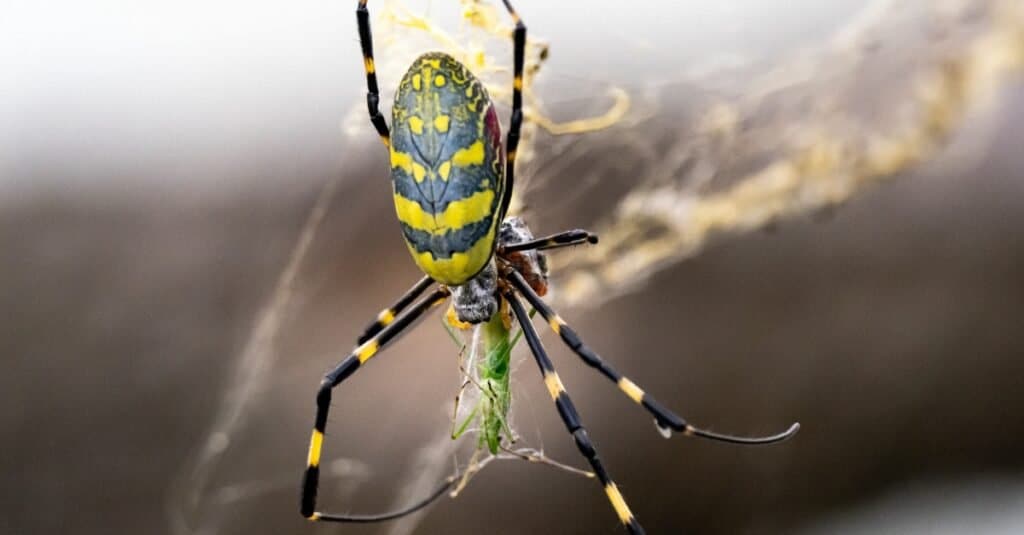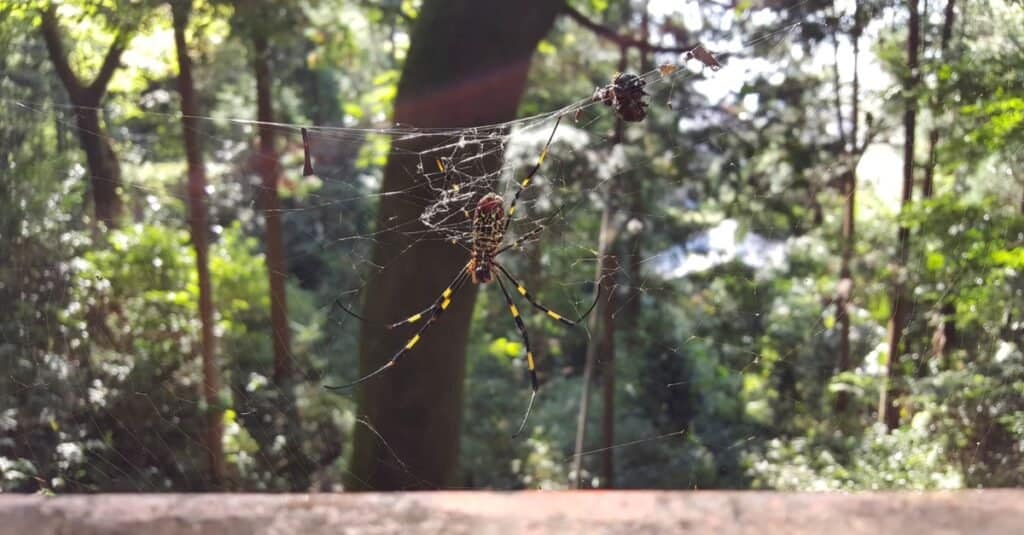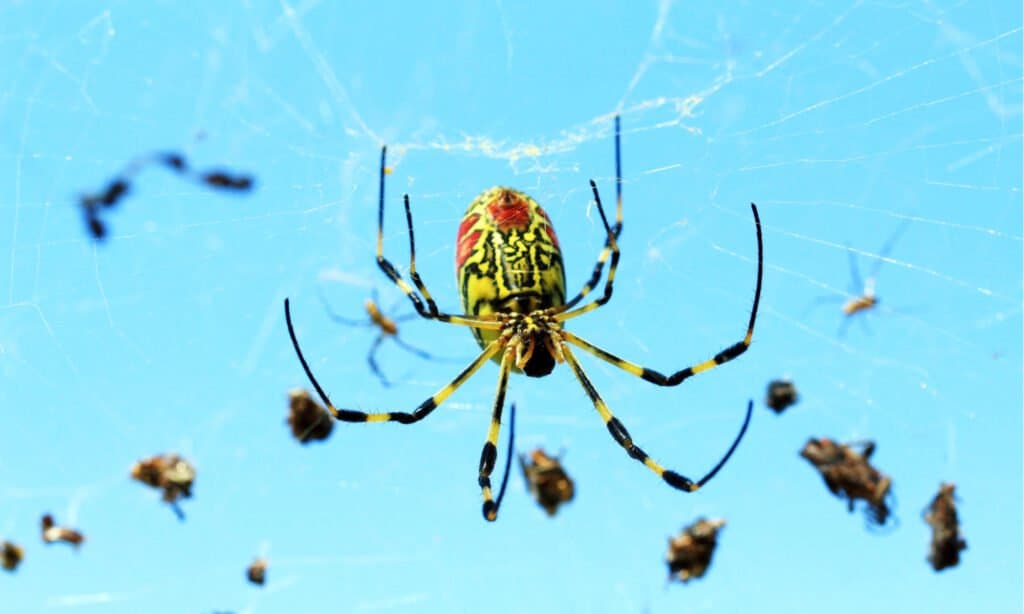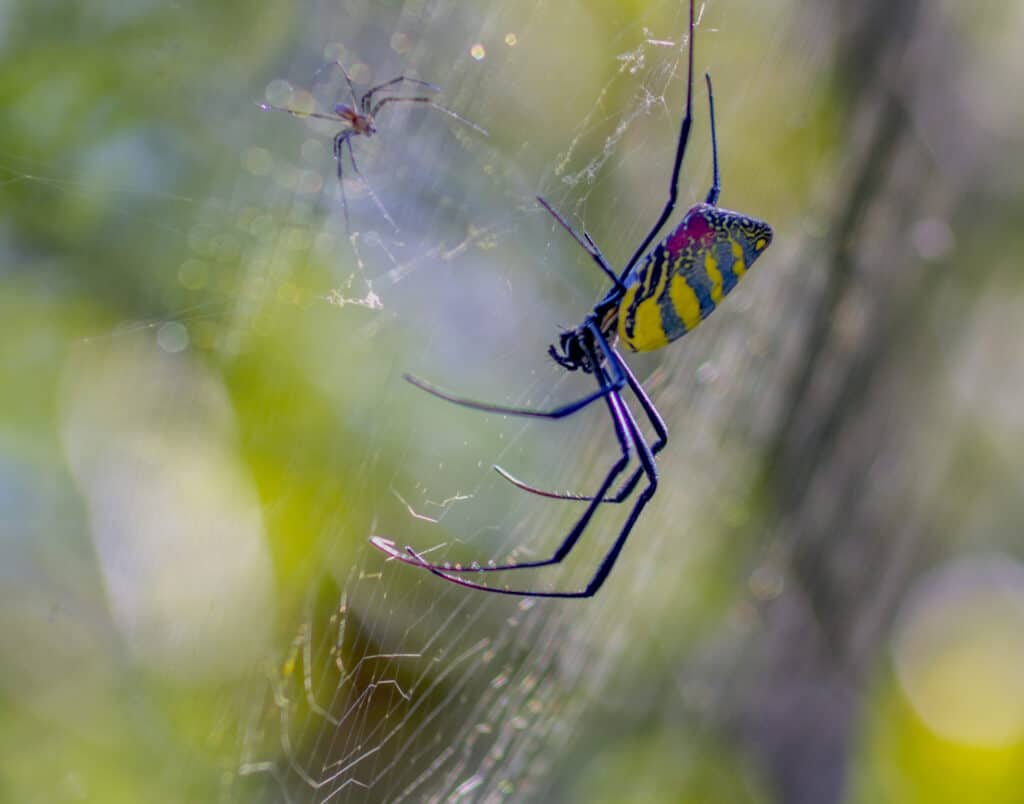Joro spiders are indigenous to Japan, China, Taiwan, and Korea but also live in Georgia and South Carolina.
Interestingly, it’s a Joro spider fact that these beautiful spiders have become an invasive species in America despite being indigenous to Southeast Asia. Also, they are helpful to people as they eat pests like mosquitoes. Besides these fascinating Joro spider facts, many others are present, which we explore below.
1. Joro Spider Facts: Females Are More Colorful

Joro spider facts are that these arachnids are indigenous to Japan, China, Taiwan, and Korea but invasive in the U.S., although set to become naturalized.
©iStock.com/David Hansche
In most animal species, the male is more colorful or extravagantly adorned. However, it’s a Joro spider fact that the female is the brighter of this species. Females have various patterns on their abdomens, which are black, red, and yellow, with blue and yellow bands along their legs. Males have brown bodies with no marks or bands. Females are also slightly larger than males. Females range between 0.6 and 1 inch, while males range between 0.27 and 0.4 inches long. However, some Joro spiders are giants, measuring between three and four inches in diameter.
2. Joro Spiders May Appear Intimidating but Are Harmless
Joro spider facts are that they are not aggressive unless threatened. However, when threatened, Joro spiders can become antagonistic and bite. But while their bites can be painful, their venom is not life-threatening. These spiders also easily live in groups but become aggressive during mating. After mating, the female Joro spider may eat the male spider. These spiders can also travel long distances. They spin silk threads, using these as balloons to fly with the wind currents. They may also hitch rides on cars or trucks and travel hundreds of miles before jumping off.
3. Fact: Joro Spiders Live Across Asia and Georgia, U.S.
Joro spiders commonly live in Southeast Asia and are indigenous to Japan, China, Taiwan, and Korea. They don’t live in a particular habitat but prefer an area with more humidity. Another Joro spider fact is that they also live in the U.S. state of Georgia. Since 2013, these spiders have become invasive in Georgia and South Carolina. Although they have not affected these states’ local ecosystems, scientists believe they will become naturalized in these areas due to the warm and humid weather. People are also not too bothered by the Joro spider in the area because they eat pests like mosquitoes.
4. Joro Spiders Have No Specific Predator

Joro spiders build a basket-shaped web and lay 400 to 500 eggs in a cocoon on this web.
©Seve Sivathas/Shutterstock.com
Joro spiders fall prey to birds and animals that eat insects and spiders. Still, they are not the main prey of any other animal species. Humans are also a threat to Joro spiders, but only if the spiders are in their homes.
5. Joro Spiders Eat Many Pests
Some people believe that Joro spiders are scary and intimidating. But it’s a fact they are beneficial to people. Joro spiders are carnivorous and mainly eat mosquitoes, though they also eat yellow jackets and stink bugs. Although they are an invasive species in Georgia and South Carolina, their diet does not affect other species. The reason for this fact is that Joro spiders eat insects that other spiders usually avoid. Joro spiders capture their prey in their impressive, basket-shaped webs. It’s another incredible Joro spider fact that this unique web captures many other spiders and prey.
6. Female Joro Spiders Can Lay Between 400 and 500 Eggs
Joro spiders have a lifespan of one year. Male Joro spiders reach sexual maturity at two months old, while females reach sexual maturity at three to four months. The female spins a basket-shaped web that hangs between tree branches. The male then joins her in the web before she lays 400 to 500 eggs in a single egg sac. Once she lays her eggs, both adults leave the egg sac, and the spiderlings hatch on their own. Once the spiderlings hatch, they can fend for themselves.
7. Joro Spider Fact: Their Name Comes From A Japanese Folklore Story
The Joro spider takes its name from a creature called the Jorōgumo. This creature, from Japanese folklore, is a spider that can transform into a beautiful woman. This woman then traps men in her web before she eats them. Another Joro spider fact is that its scientific name is Trichonephila clavata. Joro spiders belong to the family Araneidae, also known as the orb-weaver spiders. These spiders spin a web in the shape of a flat, spiral wheel. The web is deep with a golden color because it reflects sunlight.
8. Joro Spider Facts Include Being Poisonous

One fascinating Joro spider fact is that they are poisonous, but their fangs are exceptionally colorful and too weak to penetrate human skin.
©Surapong Kaewsa-ad/Shutterstock.com
These spiders are poisonous, but not to humans. Joro spiders avoid biting humans and will only do so if they feel threatened. But even if they do, their venom is too weak to affect people, which is comforting. Their poison is also ineffectual because their fangs are not strong enough to pierce a human’s skin. Fortunately, this Joro spider fact also means it is not much of a threat to pets. So, if the spider penetrates your pet’s skin, it can prompt an allergic reaction but won’t be life-threatening.
9. The Joro Spider Population Is Predicted To Grow in America
Currently, Joro spiders are invasive in America. But, these spiders are harmless and pose no threat to humans or their ecosystems. On the contrary, they have proven to help humans with insect pest populations. Scientists predict that the population of these spiders will spread in North America, mainly because they can survive in cold climates. University of Georgia researchers found that these spiders possess some abilities absent in many of their close relatives, supporting their survival. Examples of these abilities are a faster metabolism, a higher heart rate, and surviving a brief freeze. But, some scientists also believe that these spiders will sooner or later encounter a predator that will stabilize their population.
10. Joro Spiders Are A Preventable Nuisance

A close-up side view of a large colorful female Joro spider on her web. A small, dull male Joro spider waits for his chance in the background.
©iStock.com/LizMinkertJohnson
The last Joro spider fact on our list is that they pose no threat to humans or pets but can be annoying. If you want to prevent these spiders from entering your home or yard, you can take some preventive measures. For instance, you can ensure that there is no vegetation against your home where they can build nests. You could also clear your yard of possible hiding spaces. Lastly, you could turn outdoor lights off as this attracts insects that Joro spiders love, which is another interesting fact about these spiders.
Up Next – Mysterious Spider Facts
- Redback Spider
- Crab Spider
- Common House Spider
- Yellow Spiders: Joro Spider vs Garden Spider vs Banana Spider
- Flying Spiders
The photo featured at the top of this post is © iStock.com/LizMinkertJohnson
Sources
- Georgia Public Broadcasting, Available here: https://www.gpb.org/news/2022/08/18/how-do-joro-spiders-impact-the-ecosystem-uga-researchers-hope-find-out-maybe-your
- NBC News, Available here: https://www.nbcnews.com/think/opinion/most-annoying-thing-about-joro-spiders-part-why-they-re-ncna1291403
- University of Georgia, Available here: https://news.uga.edu/joro-spiders-likely-to-spread-beyond-georgia/
- The Terminix International Company Limited Partnership, Available here: https://www.terminix.com/spiders/joro-spiders/#are-joro-spiders-poisonous
- The Arena Media Brands, Available here: https://owlcation.com/stem/Facts-About-Joro-Spiders-Interesting-and-Impressive-Arachnids
Thank you for reading! Have some feedback for us? Contact the AZ Animals editorial team.






